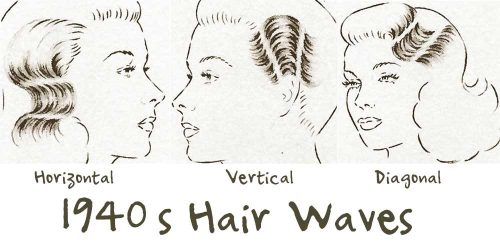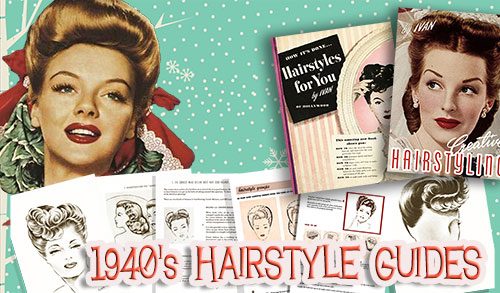How to guide to vintage 40’s waves

Basic Hair Waves
Most 1940’s hairstyles are created by using waves and curls. Here we look at the three basic hair waves.When setting a wave, do NOT force the hair. DO follow the natural wave tendencies of your hair, and the finished result will not appear artificial, will last longer and will be easier to comb. Try setting the waves with a slight curve.
The three basic hair waves
- Shadow Wave.
Shadow or soft waves are wide and the ridges are not sharp. Because this type of wave is subtle and natural looking, it is beautiful and flattering as you can see with Lauren Bacall’s famous coiffure. - Narrow Waves.
The ridges of a narrow wave are sharp and close together. Some types of fine hair do not hold a shadow or wide wave, so a narrow wave must be used even though it is not as beautiful. - Wide Wave.
These are becoming to most people and should be used extensively. The ridges are just a little sharper than those found in a shadow wave.
Hair Waves Direction
These three basic waves may take either a horizontal, vertical, or diagonal direction.

- Horizontal.
A basic wave that takes a direction is said to be horizontal ! - Vertical.
Any basic wave that takes a straight up-and-down direction is said to be vertical. - Diagonal.
Basic wave that takes a direction between horizontal and vertical is said to be diagonal.
Basic Half-Waves
A half-wave is just what it appears to be – it is one half of a full wave, and has one ridge. A half wave may take either a horizontal, vertical or diagonal direction.

- Horizontal Half-Wave.
Here we see the most popular placement of a horizontal half-wave. It molds the nape hair to the back of the head and provides a “foundation” for curls on the neck.

- Vertical Up Half-Wave
The up half-wave takes a straight up-and-down direction so it is said to be a vertical up half-wave. When a vertical up half-wave is followed by curls, it is one of the most flattering and popular mode of 1940s hairstyle.

- Diagonal Half-Wave.
A half-wave that takes a direction between a horizontal and vertical is called a diagonal half-wave. Here we see it ( left) over the ears, and (right) at the back of the head. I consider the diagonal half-wave over the ears one of the most flattering 1940’s hairstyles and is most becoming to the younger face.It is a favorite of stars such as Gene Tierney and Lauren Bacall. It is tricky to execute however.
Here are the setting instructions:

These are the three tricks used is netting the beautiful diagonal half-wave !
A. The hair at the temples is combed back away from the face.
B. Crown and nape hair is “borrowed” and combed forward to help make the diagonal half-wave over the ear. Be sure the half-wave slants up.
C. Curls numbered “1” through “5” take a backward direction. The others shown turn forward. Setting these curls in opposite directions produces additional fullness over the ears after the hair is combed out. It is most becoming !

Victory Rolls – A Classic 1940’s hairstyle

Want to learn the secrets to 1940’s victory rolls, 1940s pompadours, bangs and so much more ?, then why not get the full 1946 Creative Hair Styling book plus Hairstyles for You 1947 and a bonus 1940s makeup guide.All vintage digitally restored ebooks direct to our device.
That’s all!
© Glamourdaze
